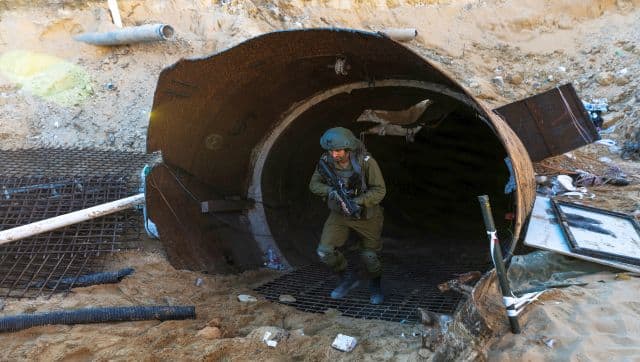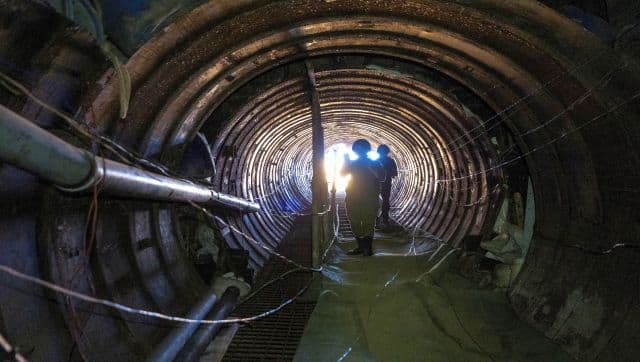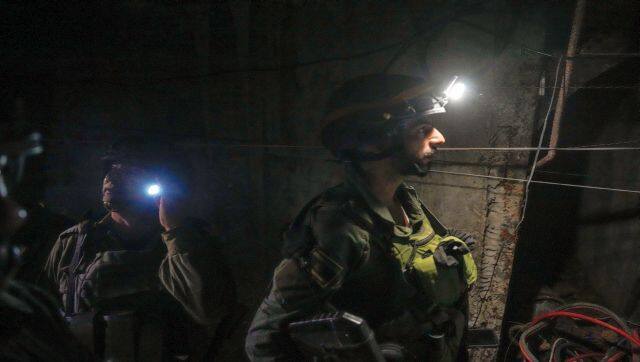The Israel-Hamas war rages on; it’s Day 73 and an increasing number of countries are demanding for a ceasefire in the hostilities. In fact, France has called for an “immediate and durable truce”, saying it was deeply concerned about the situation in Gaza. The UK and Germany also called for a “sustainable ceasefire”, but stopped short of saying it should be immediate. However, Israel’s Benjamin Netanyahu has indicated that there would be no change in its intensive military campaign. “We are as committed as ever to continue until the end, until we dismantle Hamas, until we return all our hostages,” he said. And as the battle continues, wreaking havoc and destruction across the Gaza Strip, the Israeli military announced on Sunday that it had uncovered the biggest Hamas tunnel so far, just a few hundred metres from a key border crossing. After its discovery, Israel gave journalists a tour of the extensive tunnel and here’s what we have learnt from it. Big enough to handle cars The Israeli military, tasked with destroying what they call as the Gaza Metro, uncovered a massive tunnel just a few hundred metres from the heavily fortified Erez crossing and a nearby Israeli military base. Israeli officials say that it stretches for more than four kilometres and links to the sprawling tunnel network across Gaza. Such is the size of the tunnel that it is wide enough for cars to pass through and reaches up to 50 metres underground and is equipped with electricity, ventilation and communication systems.
The military said that the tunnel facilitated the transit of vehicles, militants and supplies in preparation for the 7 October attack, which saw the killing of 1,200 Israelis as well as taking over 240 people hostage. IDF spokesperson Avijaa Adraei explained how the giant tunnel was unearthed. “Attack operations were launched from the aforementioned tunnel targeting our forces during the fighting in the Gaza Strip,” he said. “A few days ago, saboteurs were spotted inside the tunnel, and thus the IDF forces eliminated them.” The Israeli Defense Forces (IDF) said the tunnel was a part of Hamas’ “strategic infrastructure” and would be destroyed. Additionally, it added that the tunnel was a project of the brother of Hamas leader
Yahya Sinwar
, Muhammad Sinwar. However, the IDF has not provided any evidence to corroborate this claim. [caption id=“attachment_13515372” align=“alignnone” width=“640”] According to the Israeli military, the full length of the tunnel is four kilometres and runs 50 metres deep. It is equipped with electricity, ventilation and communication systems. Reuters[/caption] Israel’s chief military spokesperson Rear Admiral put the full length of the tunnel at four km, saying, “It was “the biggest tunnel we found in Gaza … meant to target the (Erez) crossing. Millions of dollars were invested in this tunnel. It took years to build this tunnel … Vehicles could drive through.” He further noted that tunnel was in use during the war and that Israeli soldiers had killed Hamas militants inside the tunnel. When asked if this was a failure of Israeli intelligence, Major Nir Dinar, a military spokesperson, was quoted as telling the Associated Press that the security services didn’t know about the tunnel before 7 October because Israel’s border defences only detected tunnels meant to enter Israel. “As far as I know, this tunnel doesn’t cross from Gaza into Israel and stops within 400 metres from the border, which means the indicators won’t indicate that a tunnel is being built,” Dinar said. He added that the entrance, a circular cement opening leading to a cavernous passageway, was located under a garage, hiding it from Israeli drones and satellite images. Speaking on the size of the tunnel, Dinar added that it was twice the height and three times the width of other tunnels found in Gaza. He also confirmed that it was equipped with ventilation and electricity and it was clear that “millions of dollars as well as a great deal of fuel and workforce had been needed to build and sustain the tunnel”. The tunnel also showed shafts plunging vertically downward that, suggesting it was part of a wider network. In a press conference Sunday night, IDF Spokesman Rear Admiral Daniel Hagari said the tunnel was “no ordinary tunnel. It’s a city. A terrorist city underground that Hamas dug and built instead of investing money in the residents of Gaza.” [caption id=“attachment_13515382” align=“alignnone” width=“640”]
According to the Israeli military, the full length of the tunnel is four kilometres and runs 50 metres deep. It is equipped with electricity, ventilation and communication systems. Reuters[/caption] Israel’s chief military spokesperson Rear Admiral put the full length of the tunnel at four km, saying, “It was “the biggest tunnel we found in Gaza … meant to target the (Erez) crossing. Millions of dollars were invested in this tunnel. It took years to build this tunnel … Vehicles could drive through.” He further noted that tunnel was in use during the war and that Israeli soldiers had killed Hamas militants inside the tunnel. When asked if this was a failure of Israeli intelligence, Major Nir Dinar, a military spokesperson, was quoted as telling the Associated Press that the security services didn’t know about the tunnel before 7 October because Israel’s border defences only detected tunnels meant to enter Israel. “As far as I know, this tunnel doesn’t cross from Gaza into Israel and stops within 400 metres from the border, which means the indicators won’t indicate that a tunnel is being built,” Dinar said. He added that the entrance, a circular cement opening leading to a cavernous passageway, was located under a garage, hiding it from Israeli drones and satellite images. Speaking on the size of the tunnel, Dinar added that it was twice the height and three times the width of other tunnels found in Gaza. He also confirmed that it was equipped with ventilation and electricity and it was clear that “millions of dollars as well as a great deal of fuel and workforce had been needed to build and sustain the tunnel”. The tunnel also showed shafts plunging vertically downward that, suggesting it was part of a wider network. In a press conference Sunday night, IDF Spokesman Rear Admiral Daniel Hagari said the tunnel was “no ordinary tunnel. It’s a city. A terrorist city underground that Hamas dug and built instead of investing money in the residents of Gaza.” [caption id=“attachment_13515382” align=“alignnone” width=“640”] Officials say that this is the largest tunnel they have uncovered yet. Moreover, this tunnel was used by Hamas to carry out the horrific 7 October attacks. Reuters[/caption] Part of a wider labyrinth This tunnel, Israeli officials say, is a part of the larger ‘Gaza Metro’ that runs below the
Strip
. In fact, a study published on 17 October by the Modern War Institute at the US military academy West Point said there were 1,300 tunnels stretching over 500 kilometres (310 miles). The tunnels under Gaza are used to smuggle goods from Egypt, launch attacks into Israel, store rockets and ammunition caches and house Hamas command and control centres. Moreover, some of the hostages released after the 7 October attack said that they had been kept inside these tunnels for days or had marched through them before being held captive elsewhere.
Also read: How Hamas uses tunnels in Gaza to target Israel
Israel has tasked the elite
Yahalom
unit to track and destroy these tunnels that run under the Gaza Strip. And the specialised unit is using various tactics and techniques to destroy these tunnels, including the use of sponge bombs as well as flooding them in order to flush out the Hamas militants. [caption id=“attachment_13515402” align=“alignnone” width=“640”]
Officials say that this is the largest tunnel they have uncovered yet. Moreover, this tunnel was used by Hamas to carry out the horrific 7 October attacks. Reuters[/caption] Part of a wider labyrinth This tunnel, Israeli officials say, is a part of the larger ‘Gaza Metro’ that runs below the
Strip
. In fact, a study published on 17 October by the Modern War Institute at the US military academy West Point said there were 1,300 tunnels stretching over 500 kilometres (310 miles). The tunnels under Gaza are used to smuggle goods from Egypt, launch attacks into Israel, store rockets and ammunition caches and house Hamas command and control centres. Moreover, some of the hostages released after the 7 October attack said that they had been kept inside these tunnels for days or had marched through them before being held captive elsewhere.
Also read: How Hamas uses tunnels in Gaza to target Israel
Israel has tasked the elite
Yahalom
unit to track and destroy these tunnels that run under the Gaza Strip. And the specialised unit is using various tactics and techniques to destroy these tunnels, including the use of sponge bombs as well as flooding them in order to flush out the Hamas militants. [caption id=“attachment_13515402” align=“alignnone” width=“640”] Israel has vowed to destroy all the tunnels built by Hamas. AP[/caption] The Israeli army said at the beginning of December that it had discovered more than 800 tunnels, with 500 destroyed. Notably, the Israeli military had uncovered a
tunnel shaft
last month on the grounds of the
Al-Shifa hospital
complex, which is the largest medical facility in Gaza. The discovery of the tunnel reaffirmed Israel’s argument that Hamas uses civilian centres as hiding places and builds tunnels under them for their safe passage and movement. Bitter fighting between Israel and Hamas has led to the loss of countless lives and destruction of property. And despite Israel losing Western support in face of the civilian casualties, it has vowed to continue the war, with its endgame being to eliminate Hamas. With inputs from agencies
Israel has vowed to destroy all the tunnels built by Hamas. AP[/caption] The Israeli army said at the beginning of December that it had discovered more than 800 tunnels, with 500 destroyed. Notably, the Israeli military had uncovered a
tunnel shaft
last month on the grounds of the
Al-Shifa hospital
complex, which is the largest medical facility in Gaza. The discovery of the tunnel reaffirmed Israel’s argument that Hamas uses civilian centres as hiding places and builds tunnels under them for their safe passage and movement. Bitter fighting between Israel and Hamas has led to the loss of countless lives and destruction of property. And despite Israel losing Western support in face of the civilian casualties, it has vowed to continue the war, with its endgame being to eliminate Hamas. With inputs from agencies
)